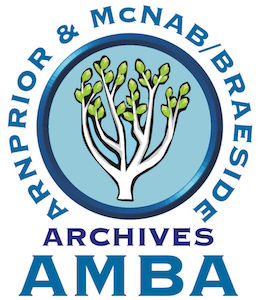Archives A-Z: AMBA's April Social Media Posts
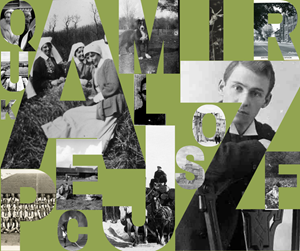

A is for Access!
We begin the Archives A to Z month-long campaign with A, for access. Part of the Arnprior & McNab/Braeside Archives' mandate is to make important historical documents available to researchers.
There are lots of resources available online, from birth/marriage/death indexes to digitized maps! We are also open by appointment and available to assist researchers remotely. Search our collections and let us know how we can help by visiting our website today!
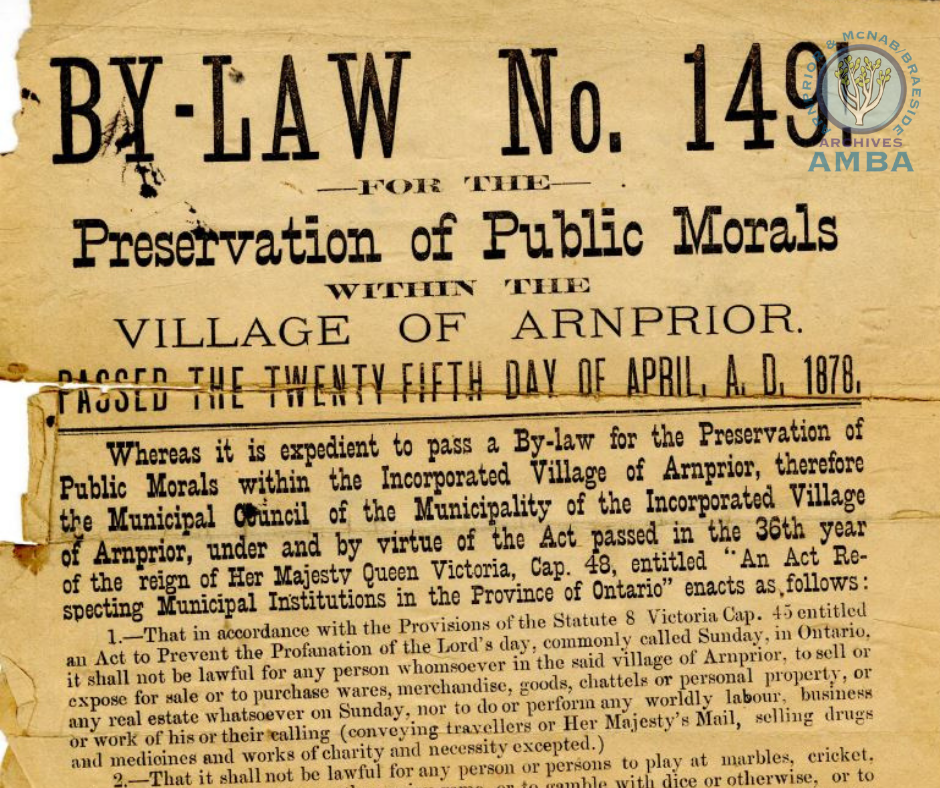
B is for Bylaws!
Did you know you can see and search the Town of Arnprior's bylaws on our website? Or that we hold McNab/Braeside Township Bylaws dating back to 1846?
Municipal bylaws contain information about public regulatory laws and can tell us a lot about permissions granted for the construction of buildings, the licensing of businesses, prohibitions passed, street regulations and much more.
This bylaw from 1878 was passed for the "preservation of public morals," which included no dancing or playing games on Sundays!
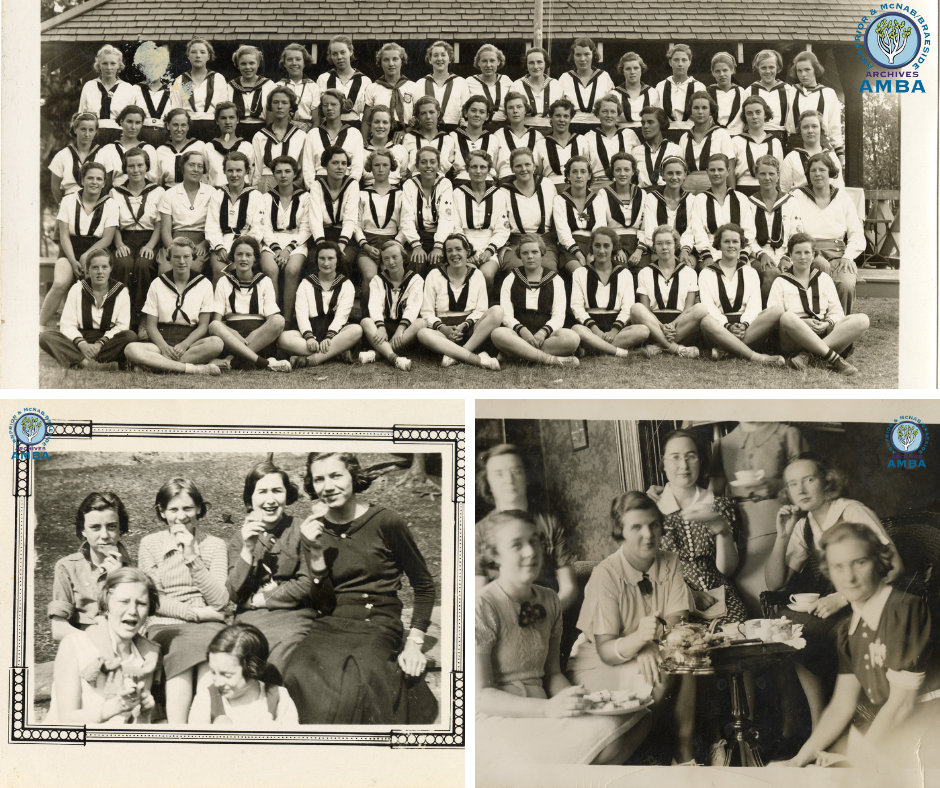
C is for Catherine McNaughton fonds!
Catherine 'Kay' Jessie McNaughton was born 22 April 1919 to Norman Lewis McNaughton and Margaret Browning Mackey. The Archives holds many collections such as Kay's that were donated by local families, and they can be a wonderful tool not only for family researchers but for anyone looking into local history.
In the 1930s, Kay was a member of the Canadian Girls in Training group. The three featured photographs are from Kay's outings with them, including camping with the group at Beau Rivage in 1936, a Christmas tea party held at Ruby McKerracher's home, and a few members on a hike to Wallace's Bridge.
Kay graduated from Arnprior High School in 1939, and was a member of the Women's Missionary Society of Grace St. Andrew's United Church in Arnprior, as well as a long-term supporter of the Arnprior & District Memorial Hospital. Her father had been part owner of Griffith-McNaughton Mill, which manufactured woollen products between 1915 and 1918, when Huyck Canada (later Kenwood) purchased it.
As an adult, Kay worked for the law firm of Mulvihill and Greene until her retirement. Her collection was donated to the Archives by her family in 2012. Among the records are several photographs of the McNaughtons and Mackeys, as well as the records of her Aunt Jessie Mackey, who worked for Kenwood Mills.
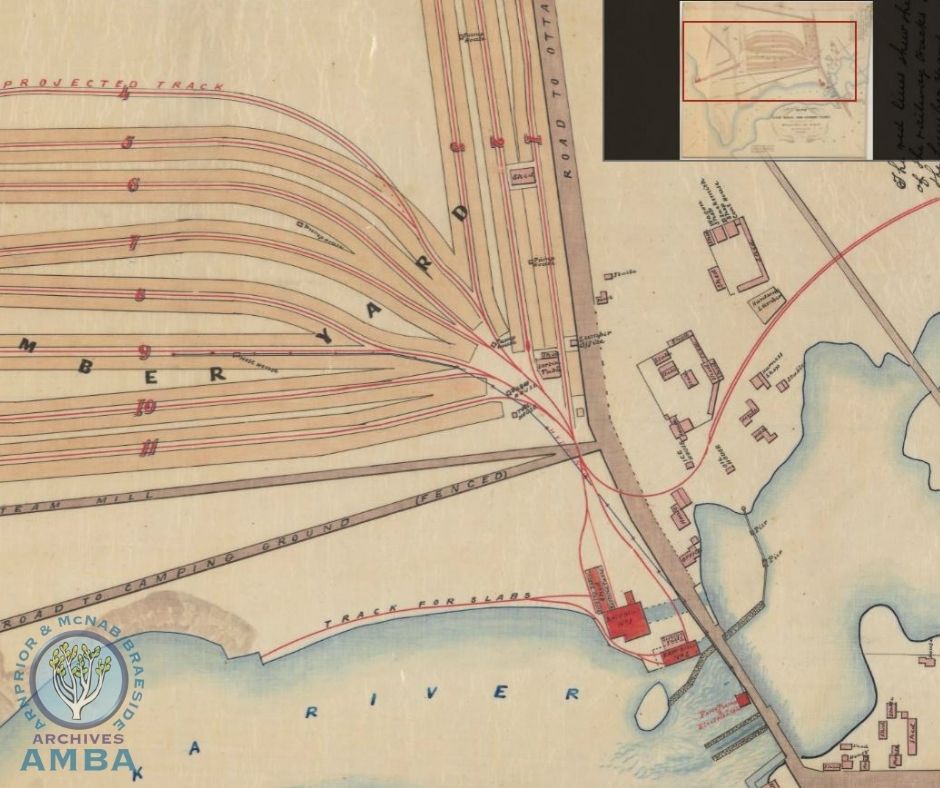
D is for Digitization!
One of the ways we make accessible the records in our care is to digitize them for our researchers to consult online. Looking to see what was once around your property in Arnprior? There are a number of maps and plans of the town available on our website in high-resolution, free of charge.
We digitized these maps in 2019 as part of our Documentary Heritage Communities Program grant, to digitize and make available the material about Daniel McLachlin and his lumbering legacy. With the help of LAC, Image Advantage and Andornot Consulting, we sent out these large maps to be scanned in high resolution and the results were spectacular!
When you've navigated to the map you want to see using the link above, use the "Zoom In" button to see them in high detail. This map is from 2004-0168 McLachlin Bros. fonds; and shows the company's lumber yards in 1884.
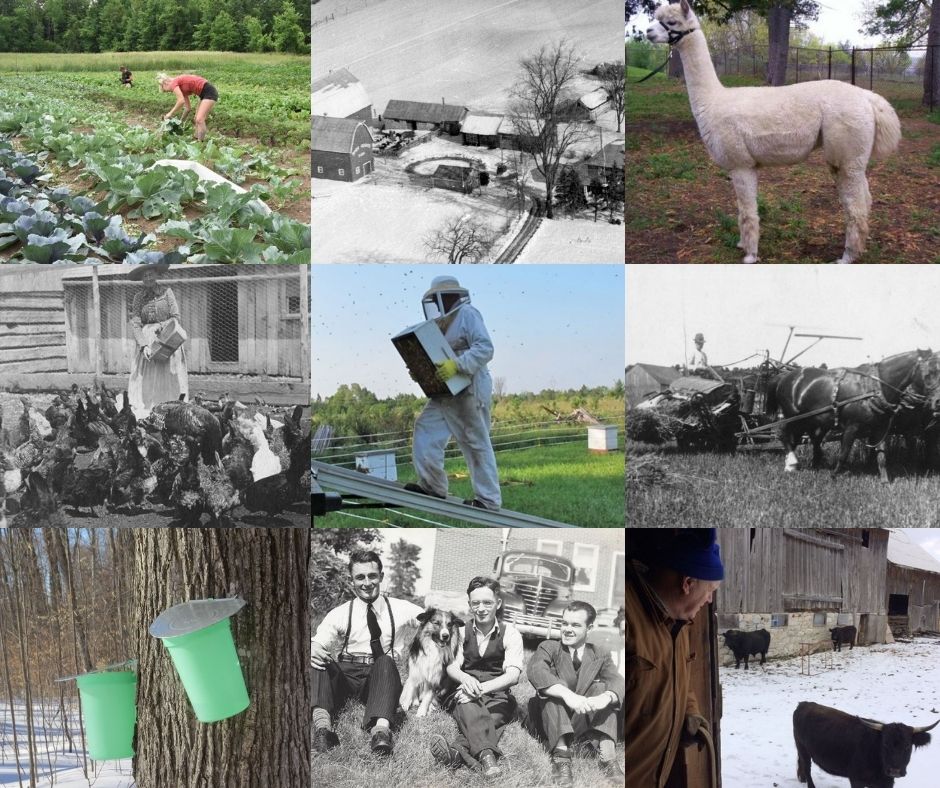
E is for Exhibits!
Exhibits are a great way for AMBA to showcase collections and local history. While we haven't been able to host any in-person exhibits in recent years, we have plenty of digital exhibits on our website.
The "150 Years Living off the Land" digital exhibit was launched in 2017. It compares what it was like to live in the McNab/Braeside Township 150 years ago with how families make a living off the land today. Follow the links in our Exhibit Gallery to discover oral history interviews, photographs and historical documents from the archives and the families who participated in the project.
A random sample of farms and businesses that currently exist in McNab/Braeside were interviewed, and we continue to welcome any comments, suggestions or addition of more information about the subject matter presented.
This exhibit was prepared by Laurie Dougherty, then-Archivist for AMBA, with the assistance of Dianne Brearley, Ella Hartwick and Matt Regan.
AMBA was very fortunate to receive funding for this initiative through the Ontario 150 Community Celebrations Program funded by the Ministry of Tourism, Culture & Sport.
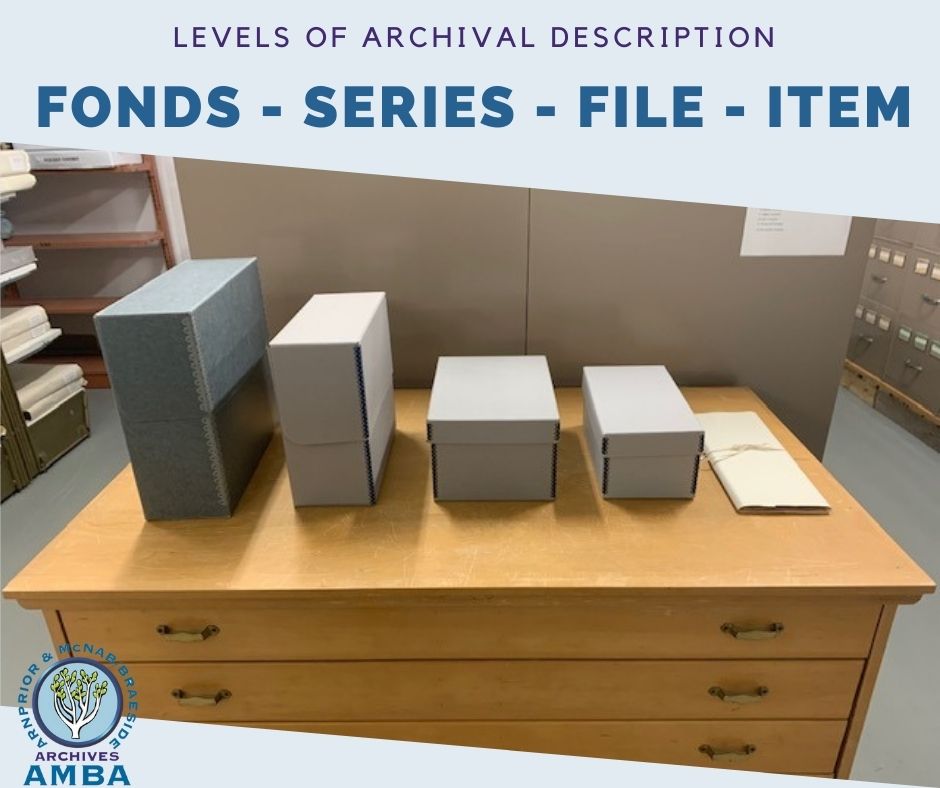
F is for fonds!
If you are familiar with Archives, you may already know the word 'fonds’, an archival term often used synonymously with the term ‘collection'. Fonds is the highest level of archival arrangement because it provides the most information about a collection. Fonds-level entries include contextual information like who once held the records (custodial history) and important historical details about them. They also contain key identifying information, including a title, a creator, start and end dates, physical description, and a scope & content note. Beneath fonds level entries, a collection may then be described even further into series, files and items.
Fonds are one level of archival arrangement, a hierarchical tool used by archivists to identify and organize collections. Arrangements respect the relationships between creators, the provenance (origin) of records and the important principle of original order.
If you've ever found material in an archive, thank an archivist for their description!
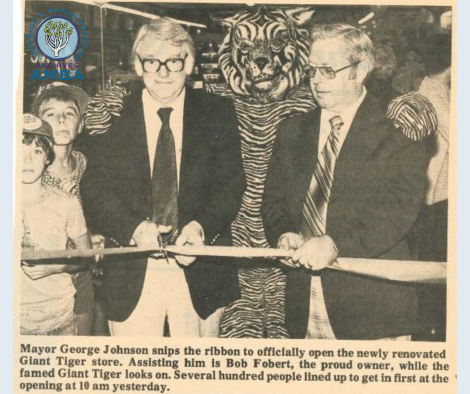
G is for Giant Tiger!
In 1973, Giant Tiger first opened in Arnprior under the ownership of Bob and Ruth Fobert and was located next to the Dominion Store parking lot on Elgin Street.
A newly renovated Giant Tiger store was then opened on 16 August 1977, and several hundred people were reported to have lined up to be the first ones to enter [Arnprior Chronicle, 17 August 1977]. The owernship of the store was passed to the Fobert's daughter in 1996.
The subject files in our reading room have information on this and many other local businesses, people and places in Arnprior, clipped from duplicate issues of newspapers by our dedicated volunteers!
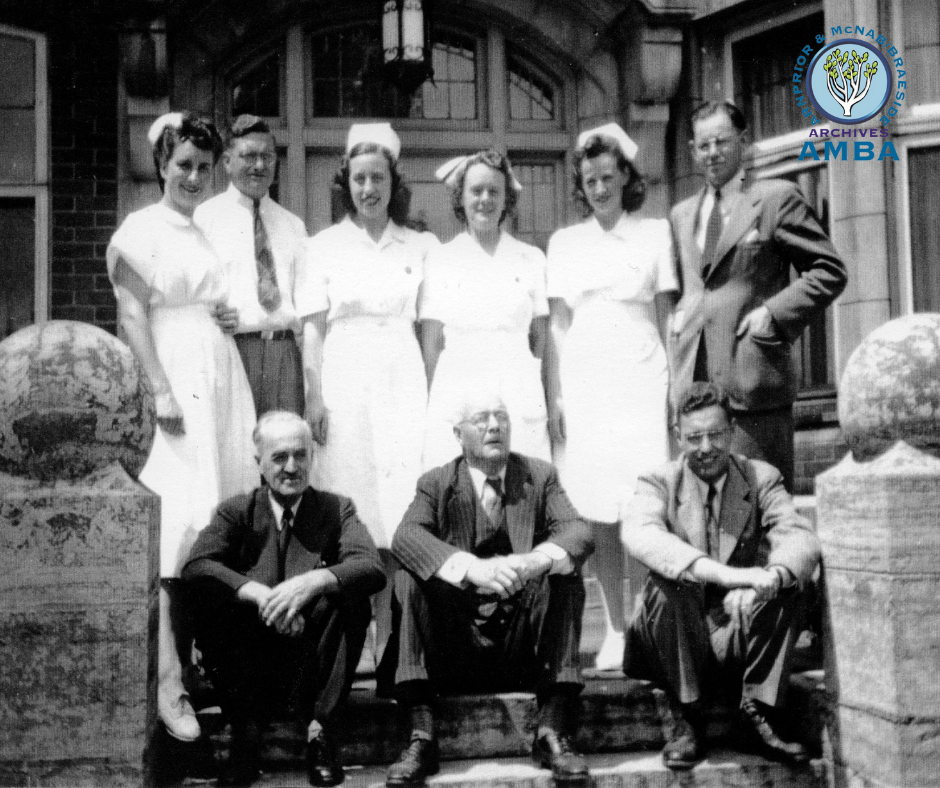
H is for Hospital!
This photograph is of the staff of the Arnprior District Hospital, c.1945. Included in the photograph, left to right and top row to bottom are Isobel McNab, Dr. D. Best, Edna Wolff, Mary Devine, Gwen Campbell, Dr. R. H. McCreary, Dr. J. H. Box, Dr. W. B. McNaughton, and Dr. H. R. Giberson.
The Hospital was established thanks to the efforts of several individuals in the 1940s. Dr. A. H. Reid (mayor of Arnprior from 1938-1945 and a dental surgeon) approached Daniel McLachlin with the request to sell land for a hospital in town. McLachlin ultimately agreed to convey his house and a parcel of land (250 ft. by 300 ft.) for the ultimate purpose of a hospital in 1943. This site eventually became known as the Arnprior and District Memorial Hospital (ADMH).
Dr. Reid, Dr. J.A. Box and Mr. H. A. Short were also driving forces behind the formation of the hospital, and a wing was named after Dr. Box -- the J.H. Box Wing. In 1944, the first meeting of the Directors of the ADMH was held in Grace St. Andrews United Church Parish Hall.
This photograph and several others were donated by Muriel Saunders to the Archives in 1997, and they feature the staff of the hospital in the 1940s. Mrs. Muriel Saunders was the first woman Hospital Board member in 1960 and an honorary life director after 1987.
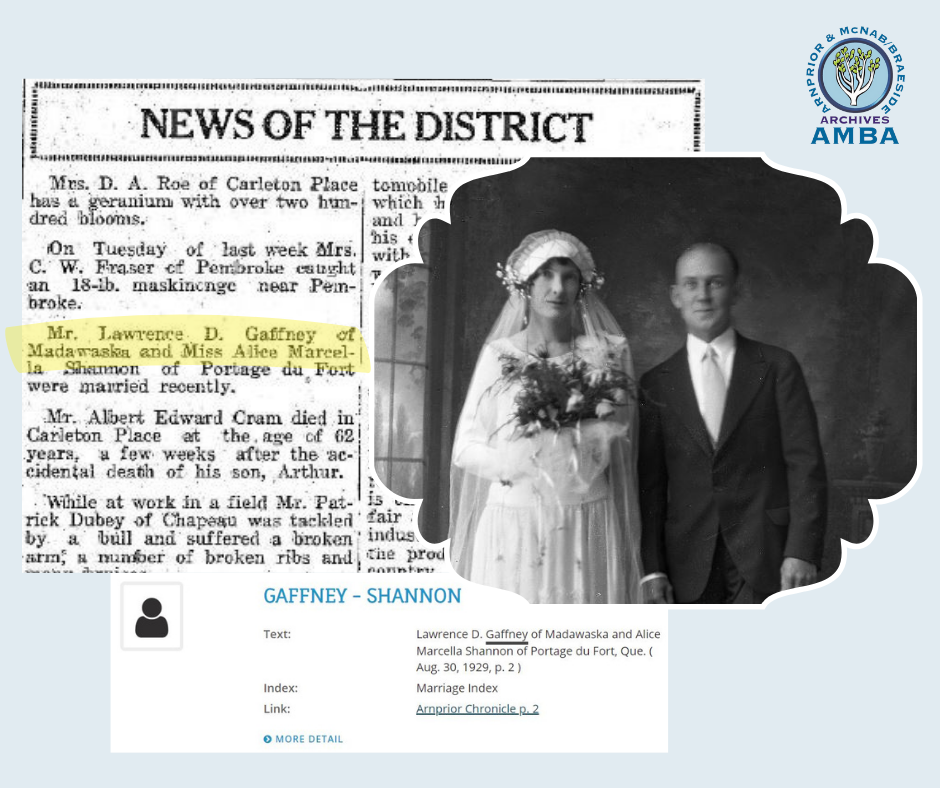
I is for indexes!
Have you seen our Birth, Marriage and Death indexes? If you're looking for information about local family members between the late 1800s and mid-1936, you're in luck!
Over the last 25 years, our dedicated volunteers have prepared a listing of all of the birth, marriage and death notices in the local papers from this time period, and they have recently been linked to the now-digitized issues of the papers online.
Using our search page, you can enter an ancestor's name and end up with their original birth, marriage or death notice that was published in the paper at the time that it happened. Go to https://search.adarchives.org/ to try it!
In the photo above, we were able to find a wedding photo from the Handford Collection (2008-0233) of the marriage of L. Gaffney and Miss Alice Marcella Shannon. We searched for Gaffney in the index and found the notice from the August 8, 1929 issue of the Arnprior Chronicle.
The project to link the index to the paper was funded by the Ottawa Branch of the Ontario Genealogical Society and we are very grateful for their continued support!
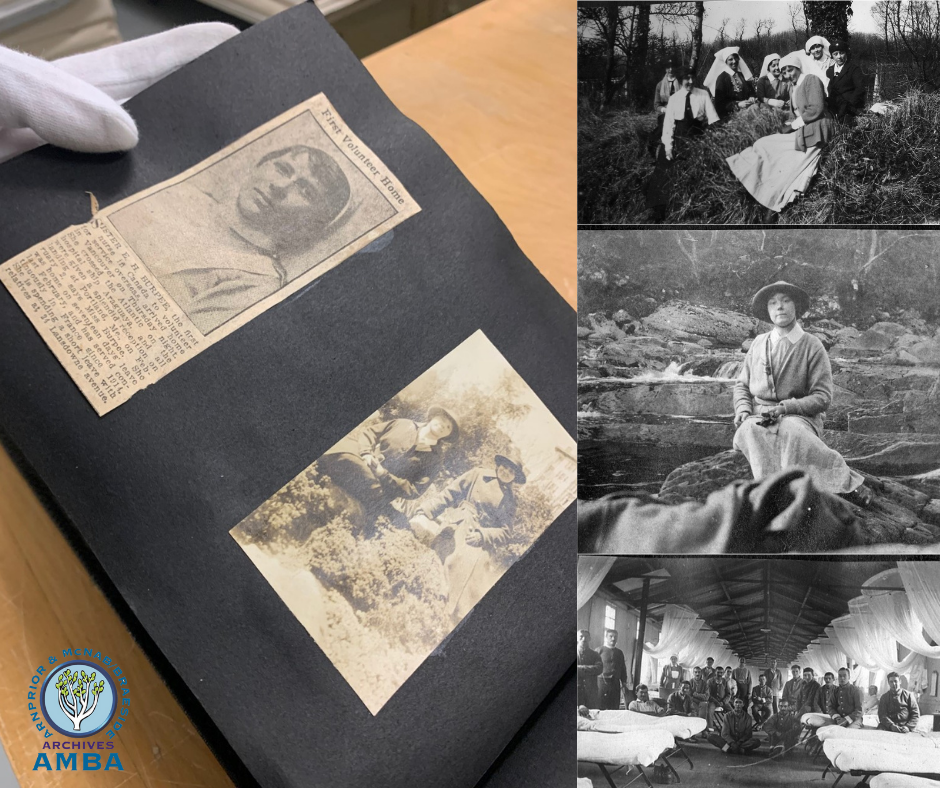
J is for Journal!
Annie Riddell was a registered nurse who served in England as a nursing sister in World War I (1914-1918) with the Canadian Army Medical Corps. She was from Galetta, a small village just east of Arnprior.
During the war, she kept a journal and took many photographs. They depicted herself, her fellow nursing sisters, landscapes, the barracks where she stayed and the soldiers that she took care of. Soon after the war, she died of pneumonia in New York in 1920.
Her journal is in the Arnprior & District museum collection at the AMBA and is currently on loan to the Museum, where it has been on display alongside other objects from WWI.
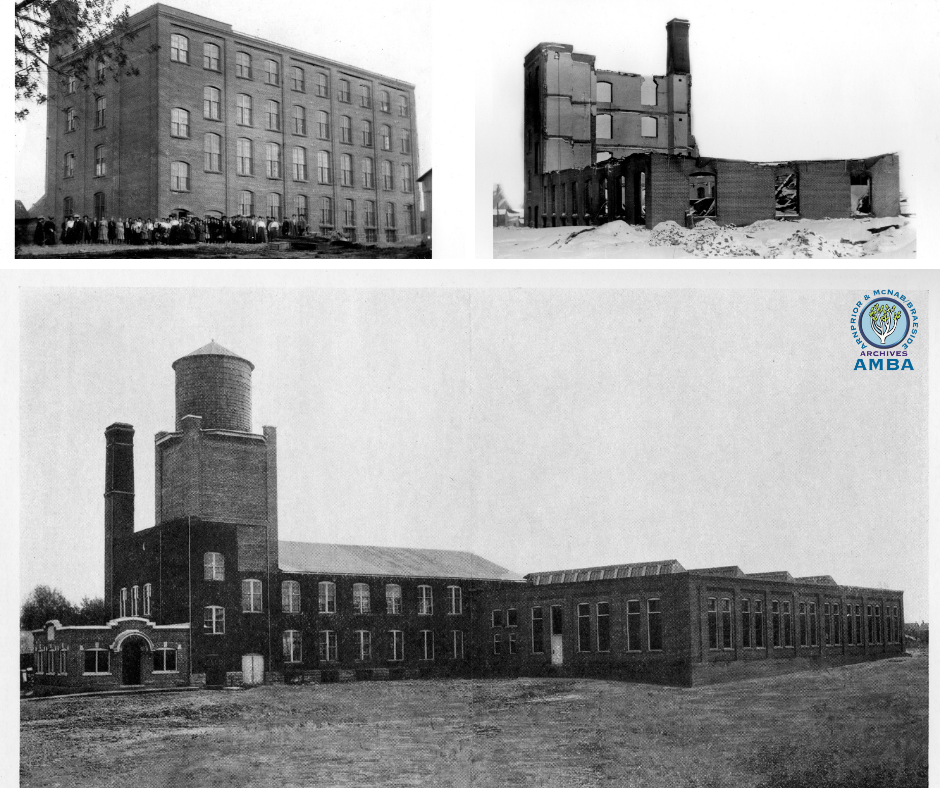
K is for Kenwood Mills!
The featured photographs are of the first structure that would become the Kenwood Mills before and after the fire that destroyed it in 1907.
The Kenwood Mills of Arnprior (famous for their wool Kenwood blankets) began in 1918 when the US company F.C. Huyck & Sons took over a factory building owned by Griffith & McNaughton on William Street in Arnprior. Huyck named the Arnprior factory “Kenwood Mills” after a village near Albany, New York where the American owners had operated their mill for years.
In the 1960s and 70s, Kenwood switched from the production of their famous blankets to the production of paper machine clothing (large continuous felts used by paper manufacturers). For a time, Kenwood was the largest employer in town, with 300 employees. In 1962, the Kenwood operation was amalgamated with another Canadian Huyck subsidiary to become Huyck Canada Ltd. The Arnprior plant was later taken over by Weavexx, which closed its Arnprior operations in 1996.
Numerous collections in the Archives belong to past employees of Kenwood/Huyck and include photographs, newspaper clippings, photographs and brochures.
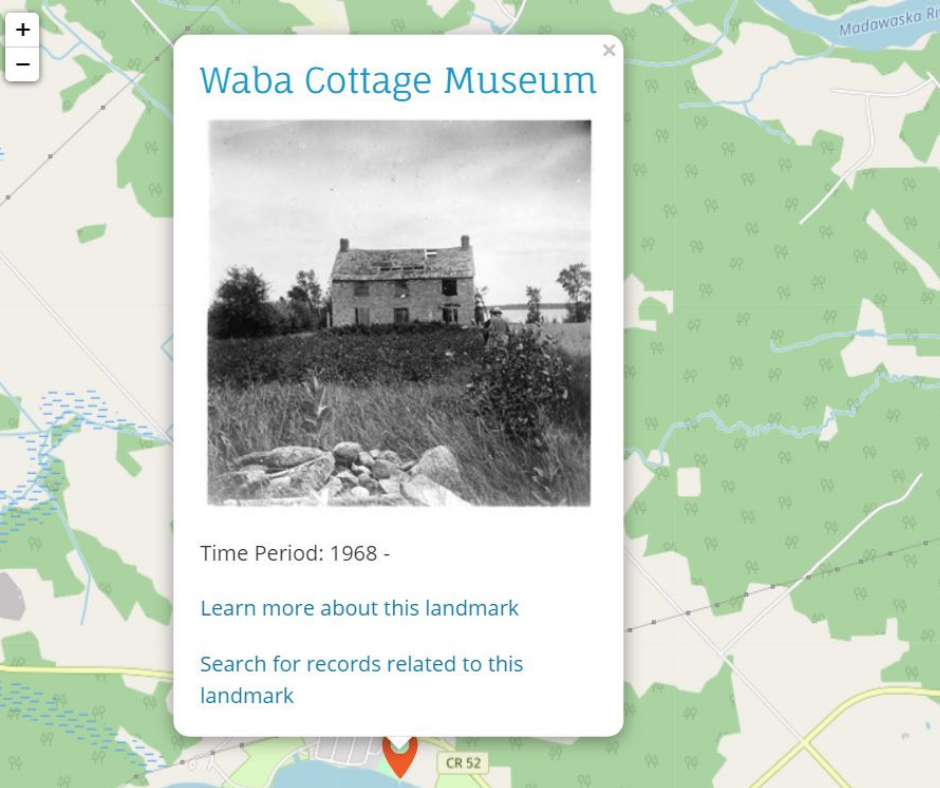
L is for Landmarks!
Did you know that we have interactive maps on our website that point to local historic places and buildings? We have three themed Places of Interest Maps that we are adding landmarks to on an ongoing basis. Above is the pin for Waba Cottage Museum.
The featured photo was taken about 1925, and is of the original Waba Cottage that the infamous Laird McNab had built and lived in from 1835 to 1845. It was lived in by the Laird's relatives until 1884, when it was left to the elements until it was demolished in 1936 under mysterious circumstances. In 1967, it was rebuilt using some of its original stones, and it became the Waba Cottage Museum and Gardens that we know and love today.
Browse the places of interest here: https://bit.ly/38C9wqa
We have three themed maps for you to explore: Daniel McLachlin and the Lumbering Era, Gillies Mill and Braeside history, as well as General Interest. Each landmark pin has a link that will bring up any related material in our collection. If you have an idea for a future map or a landmark to add, please get in touch!
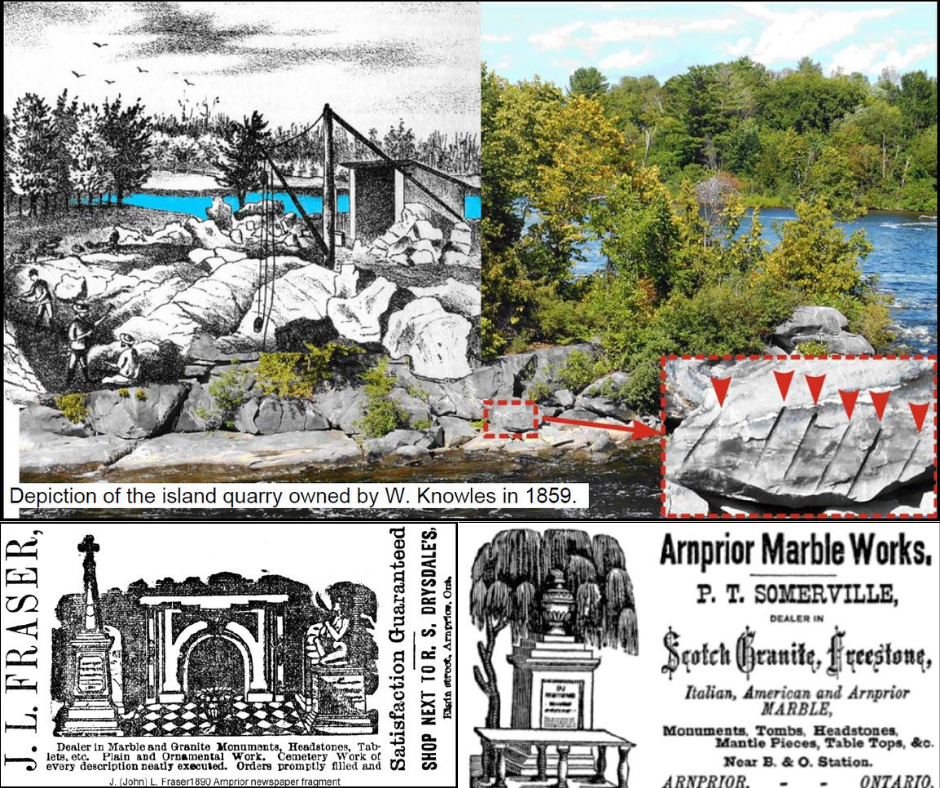
M is for Marble!
Did you know that Arnprior has its own marble history, and a type of marble named after it? Arnprior once had a successful marble industry with multiple quarries in and around town. Volunteers Dave and Mary Forsyth performed extensive research into the marble history of the area, and wrote a book that we have on our reference shelf!
The Arnprior Marble industry was well underway before Daniel McLachlin's arrival and the lumber boom that soon followed. The beautiful stone was used in cemetery monuments, local buildings, and was even used for elements of Canada's first Parliamentary and Departmental Buildings.
Some of the original quarry sites are still visible today. One (pictured here) is on the island in the middle of the Madawaska River, to the north of the Madawaska Street bridge. One notable Arnprior building that features Arnprior Marble is in the second photo: The Scotiabank building, built around 1870.
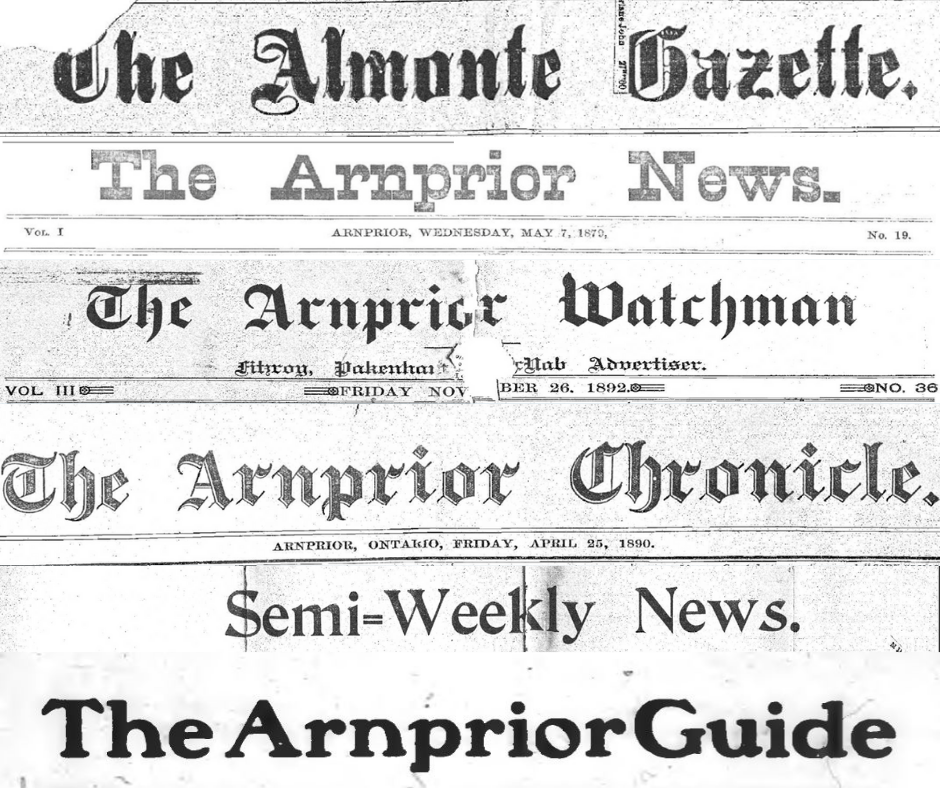
N is for newspapers!
Newspapers are an invaluable resource to anyone interested in local history. For the genealogists, they have notices of births, marriages, deaths and social occasions. For historians, there are countless big and small news items about local, national and international events of the time. Examine the advertisements and track the presence of local businesses or the prices of goods and services over the years. The possibilities are endless, but you'll need access to them first!
Over the last 5 years, the Arnprior & McNab/Braeside Archives has embarked on a monumental project to digitize the issues of Arnprior newspapers. This collection includes several different area newspapers that were published on a weekly basis. Most newspapers in the collection were published in Arnprior or contain content related to the Arnprior area.
We sent out our microfilm and our paper issues to be scanned offsite, and we now have hundreds of digitized, downloadable and searchable issues on our website from the mid-1800s all the way up to 1975! Browse the finding aid here: https://bit.ly/3F1c8Jx
The newspaper digitization project is funded in part by the Ottawa Branch of the Ontario Genealogical Society, who provided the funding for digitizing up to 1937. The Government of Canada, through the New Horizons for Seniors Program, provided funding to digitize up to the mid-1970s.
Have any old newspapers kicking around? Due to missing and damaged issues, the AMBA is always looking for more papers. We receive donations that fill the gaps in our collection on a regular basis, and we are always on the lookout for more!
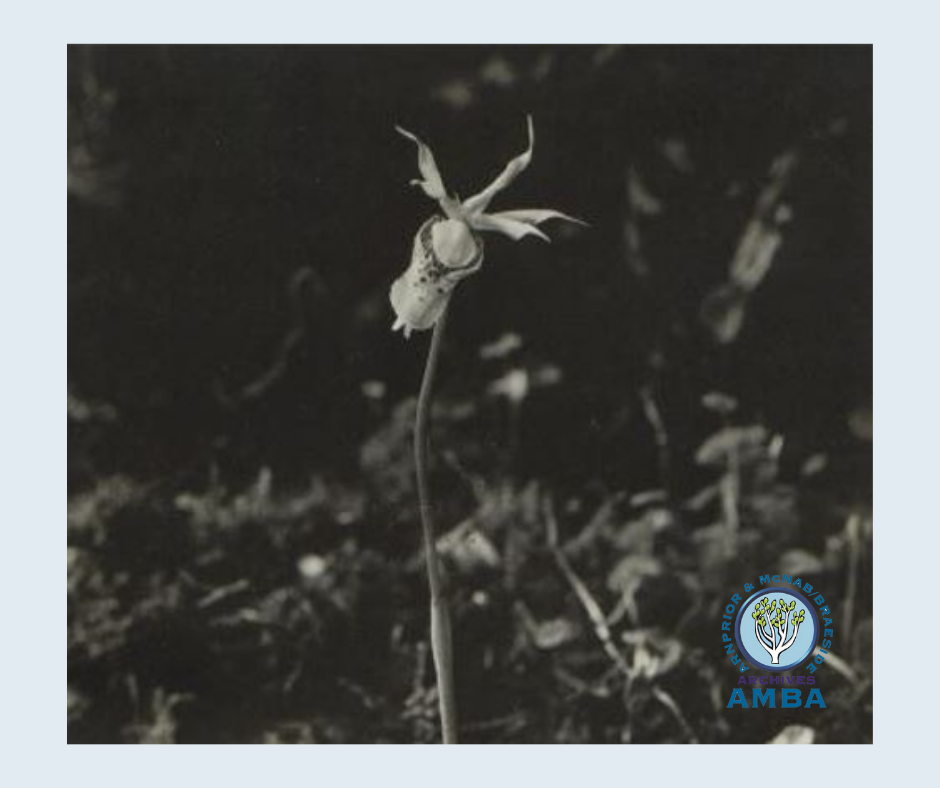
O is for Orchid!
Did you know that the Ottawa Valley is home to several native species of orchid, and that there are over 50 species in Ontario as a whole?
Charles Macnamara lived in Arnprior from 1881 to 1944, and worked as secretary-treasurer for the McLachlin Bros. Lumber Company. Macnamara was also a renowned amateur naturalist and photographer. He was very interested in the orchids that grew around him in the Ottawa Valley, like this Calypso bulbosa (or Fairy Slipper), pictured above.In his notes about the plant, Macnamara wrote, "Calypso bulbosa (L.) Oakes. Not uncommon in Western America, it is the rarest of orchids and most highly prized of collectors in the East. Called after the nymph Calypso who beguiled Ulysses in her isle for seven years, and died of grief when he broke away. It grows here in thick mossy woods."
This photo is just one example of Macnamara's artistic sensibility and his dedication to the nature around him. His work as a naturalist inspired the Macnamara Field Naturalists' Club, which was established in 1984 and still meets monthly today.
In 2003, archivist Laurie Dougherty created an online exhibit called "Charles Macnamara: A Retrospective" with a Community Stories grant from the Virtual Museum of Canada (now Digital Museums Canada). The exhibit dives into Macnamara's life and work, illustrated by his many beautiful photographs. The Virtual Museum of Canada website was decommissioned in 2020, but the Community Stories are still hosted on the Digital Museums Canada website.
Explore the exhibit here: https://bit.ly/3uytLxh
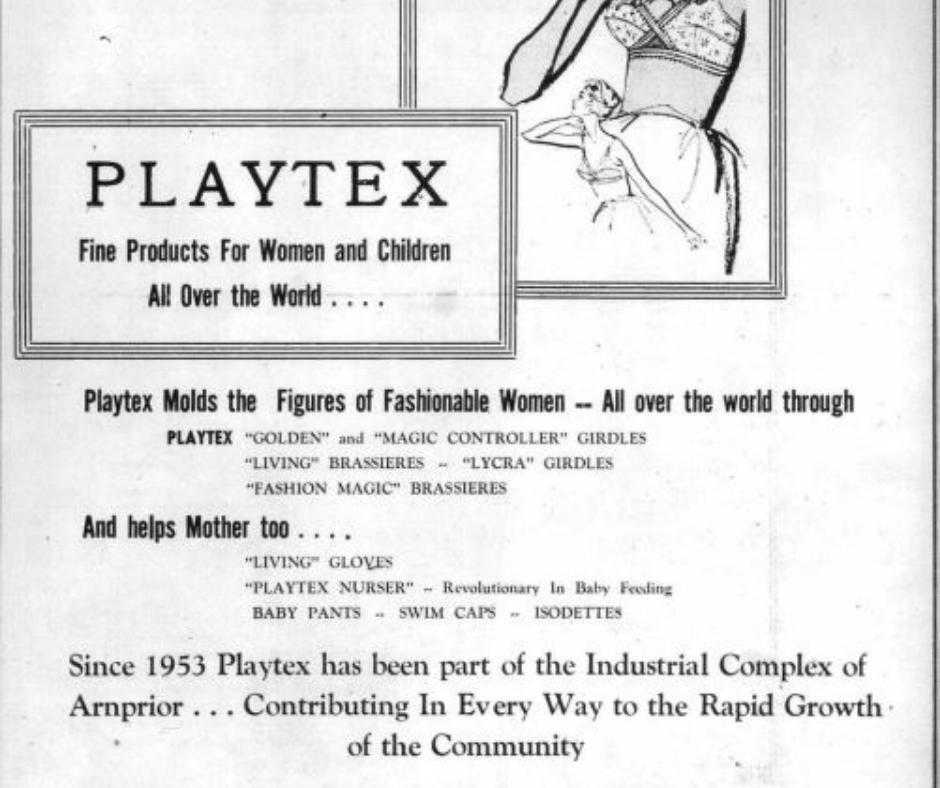
P is for Playtex Ltd!
The Playtex Ltd. plant in Arnprior opened in September of 1953 as the first expansion plant of the International Playtex Corporation which had its head office in Dover, Delaware. When the Arnprior plant closed in 2006, their records were transferred to the AMBA, who became the caretakers of hundreds of photographs, issues of the company newsletters, and other records.
Playtex in Arnprior was a major employer with around 400 employees by 1967, at first manufacturing latex products such as girdles, gloves and infant's wear. The manufacturing facility of over 90 thousand square feet was built by Sullivan & Son Ltd. of Arnprior. In the 1970s, fabric girdles, panties and brassieres as well as tampons and swim caps were manufactured here. Around 1978, the sewing and cutting departments moved to the former RCA Victor plant in Renfrew, Ontario.
Social activities were a large part of the life of the plant, including annual family picnics, sports teams, dances, contests and more. "The Supporter" newsletter was created by several Playtex employees and published two or three times per year and featured stories and photographs of employees, events, and company updates.
The Arnprior plant closed in 2006 following several years of corporate changes. By then, various lines had already been moved off-shore or back to the head plant in Dover.
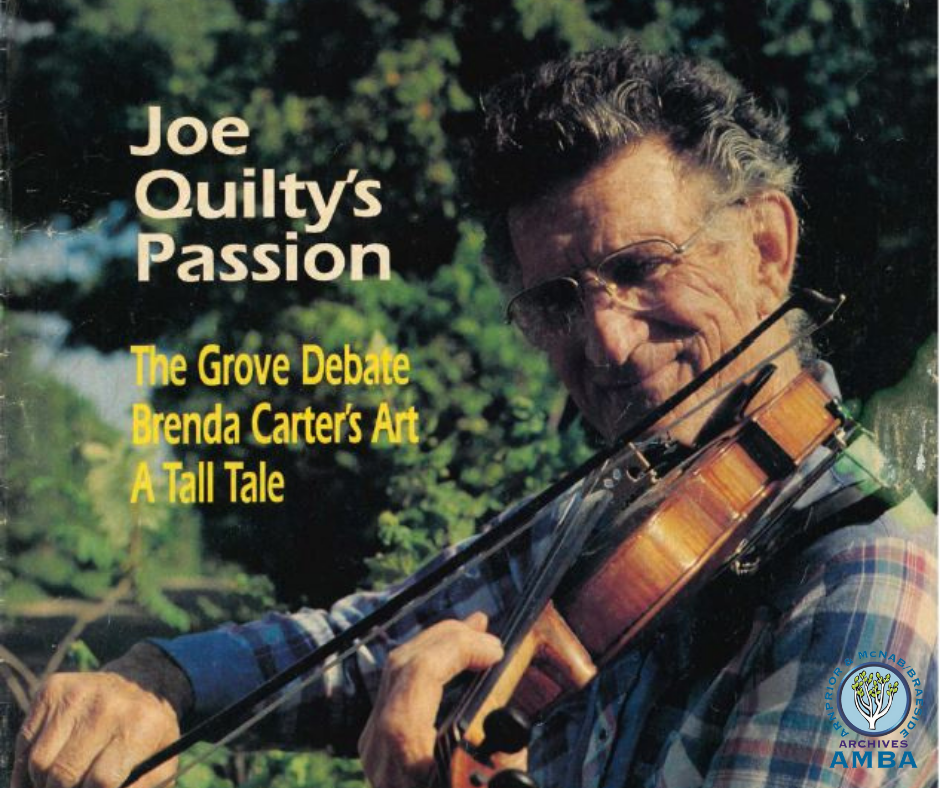
Q is for Quilty!
Joe Quilty's love of old-time music and his passion to preserve heritage fiddling in particular caused him to get an association started in Renfrew County.
On May 28, 1978, Tom Sharbot, Ed Mayhew and Joe Quilty met to discuss the possibility of forming a Renfrew County Fiddlers Association. On June 16, 1978, the first Fiddle Jamboree was held in St. Joseph's High School in Calabogie, Ontario. The Association was then formed on June 20, 1978.
Throughout the first twenty-five years, there were eight presidents: Joe Quilty, Sheldon Church, Ken Spence, Milton Symington, Dennis Harrington, Murray Spence, Dalton Hein and Barry Martin. To celebrate its 25th anniversary year in 2003, an Old Tyme Hoe-down was held at the Renfrew Armouries on Saturday June 7. The association's own fiddlers, musicians and guests supplied the entertainment. The records of the association were donated to the AMBA in 2008.
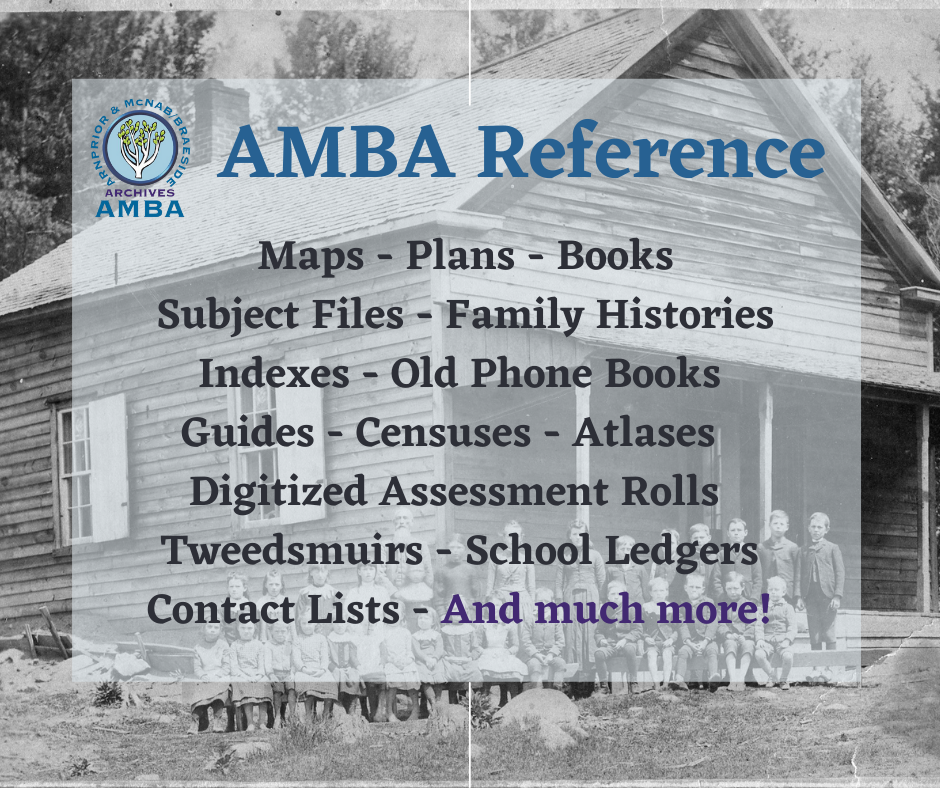
R is for Reference!
The Arnprior & McNab/Braeside Archives has a wealth of physical and digital reference information available in our reading room. We have books, maps, indexes, atlases, and more for you to consult in conjunction with your archival research.
Many of the items in our reference collection were compiled or written by our volunteers over the past 28 years. Some highlights of this collection include genealogical family trees of local ancestors, guides and finding aids to the land records, lists of local photographers through history, and hundreds of subject files on local businesses, people and places from the beginnings of Arnprior to today.
One recent addition is an index of names from the St. Celeste cemetery, compiled by volunteer Doug Collins. The St. Celeste cemetery was flooded when the Hydro dam was built on the Madawaska. Remains from the cemetery were transferred to the Malloch Road Cemetery, but some were without headstones and names. Doug looked into Parish burial records found burials listed in the St. Celeste Cemetery, translated them from French, and compiled them in an index. This invaluable aid can help descendants identify ancestors whose names were lost before or during the move.
Our reference material is searchable on our website, and much of it is accessible in our reading room. At the moment, we are open by appointment only - but no request is too small for an appointment to be booked. Read more here.
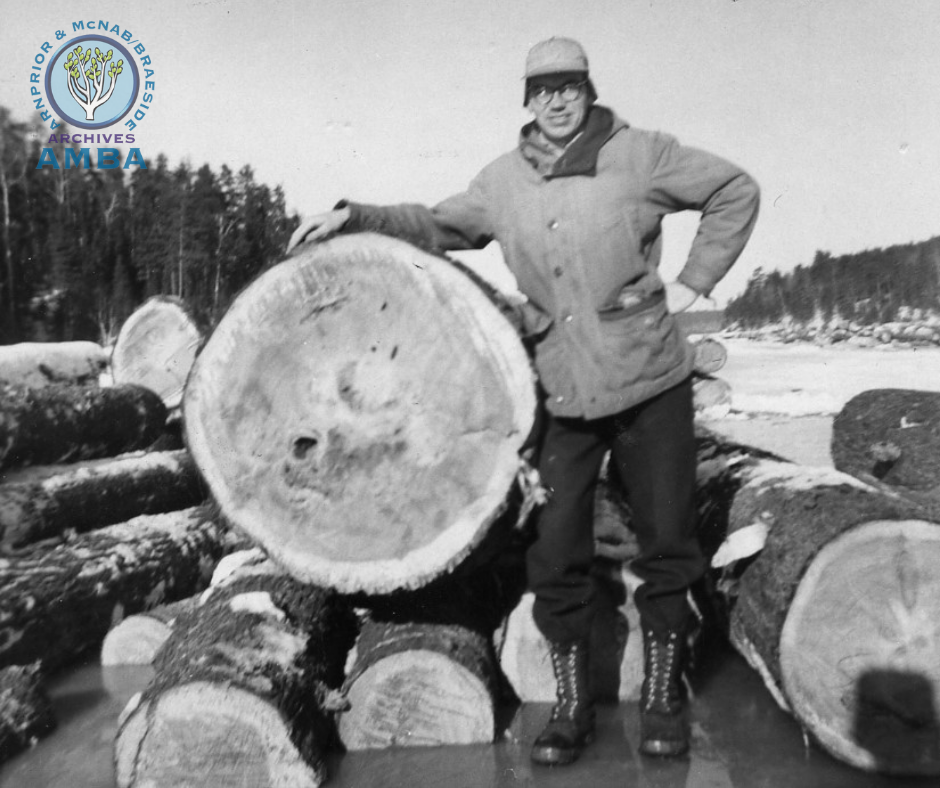
S is for Sloan!
Sloan Watters worked for Gillies Bros. lumber company from the time he was twenty in 1947, until his retirement in 1991. He started work as a truck driver in Temagami and later became a log scaler, timekeeper, paymaster, depot clerk and office manager. He kept a journal of activities including some photographs and articles related to the lumbering in the area while working for Gillies Brothers Ltd.
Mr. Watters was transferred to Braeside in the 1960s when he became the Purchasing agent for all Gillies’ operations. He worked in that capacity until Consolidated Bathurst built a pulp mill in Portage du Fort, Quebec in about 1981.
Sloan donated many items to the AMBA from 2001 to 2010. He also gave an interview with curator Laurie Dougherty, for the Community Stories project, "White Pine College: Gillies Mill and the Village of Braeside," a Virtual Museum of Canada Exhibit completed in 2020. Hear an excerpt of the interview and look at the rest of the exhibit here.
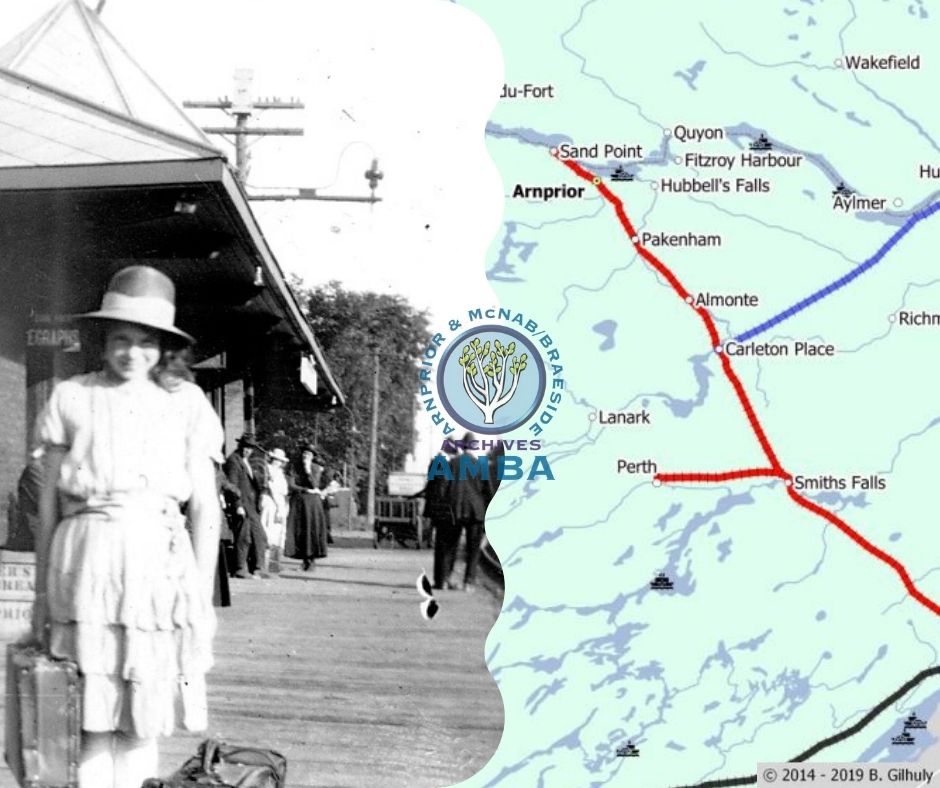
T is for Trains!
The Ottawa Valley was once densely networked with railway lines. Today, most routes have been abandoned. Some of those routes can still be traced on foot, as they've been made into recreational trails.
AMBA volunteer Brian Gilhuly tackled the history of the Valley's railways in a presentation to the AMBA's Annual General Meeting in 2015. This presentation garnered great interest, and out of this interest came a publication. Originally published in 2015 and revised in 2016 and 2019, it is called "Tracing the Lines: The Railway History and Geography of Eastern Ontario and West Quebec" by Brian Gilhuly.
The book details the competing interests that created the railway lines as well as the local, national and international events and politics that affected their evolution from the 19th century through to the 21st. From the settlement of the shores of the Ottawa River to the CN and VIA Rail that operates in the area today, the book is aided by interactive maps that show the layout of railways in the area every few years.
Read the PDF on our website here.
The featured image is on the cover of the book, and is of an unknown girl on the platform at the former OAPS station in Arnprior c1910 [1993-0017 P0345]. The background is a part of a map of the railway lines in 1870, copyright Brian Gilhuly. Do not reproduce without permission.
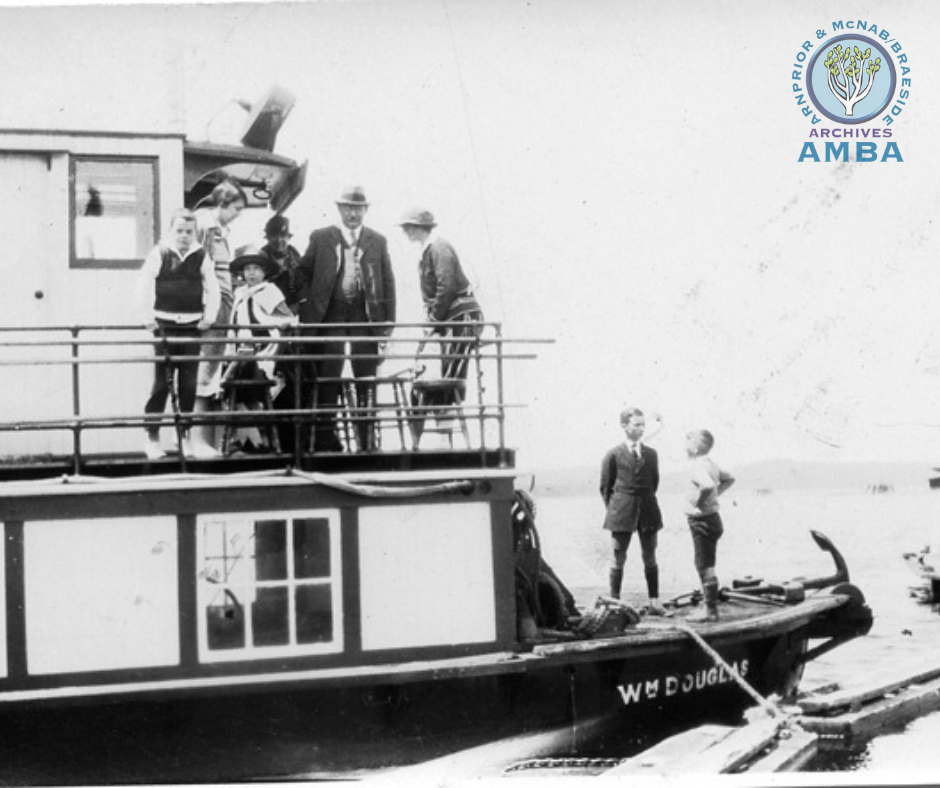
U is for Underwater!
The many years of transporting lumber on the Ottawa River left a mark on the environment that is still visible today. Along with a huge number of logs and bark chips that sank to the bottom of the water, there is a mysterious shipwreck in Chats Lake.
At some point in the late 1800s, an alligator tugboat used for lumbering was submerged along with 5 rock cribs at the bottom of Chats Lake, near the Gillies Mill site at Braeside. In 1999, the Ottawa Chapter of the group Save Ontario Shipwrecks created an archaeological report on the site, complete with pictures and drawings of what they found. This report is in the Peter Hessel collection (1994-0021). The wreck looks as though it burned before being submerged, and is now covered in a layer of silt, debris and freshwater clams.
While they could not positively identify the boat in the end, they considered the possibility that it was the William Douglas, a tugboat used by the Gillies Bros. in their lumbering operations. In the Sloan Watters fonds (2001-0131) there is a file called “Alligator” that contains blueprints, a 1936 license and inspection certificate and other information about its parts. It was scrapped and used as a buoy in Red Pine Bay in June of 1953. The mystery of the burned shipwreck analyzed in 1999 remains unsolved.
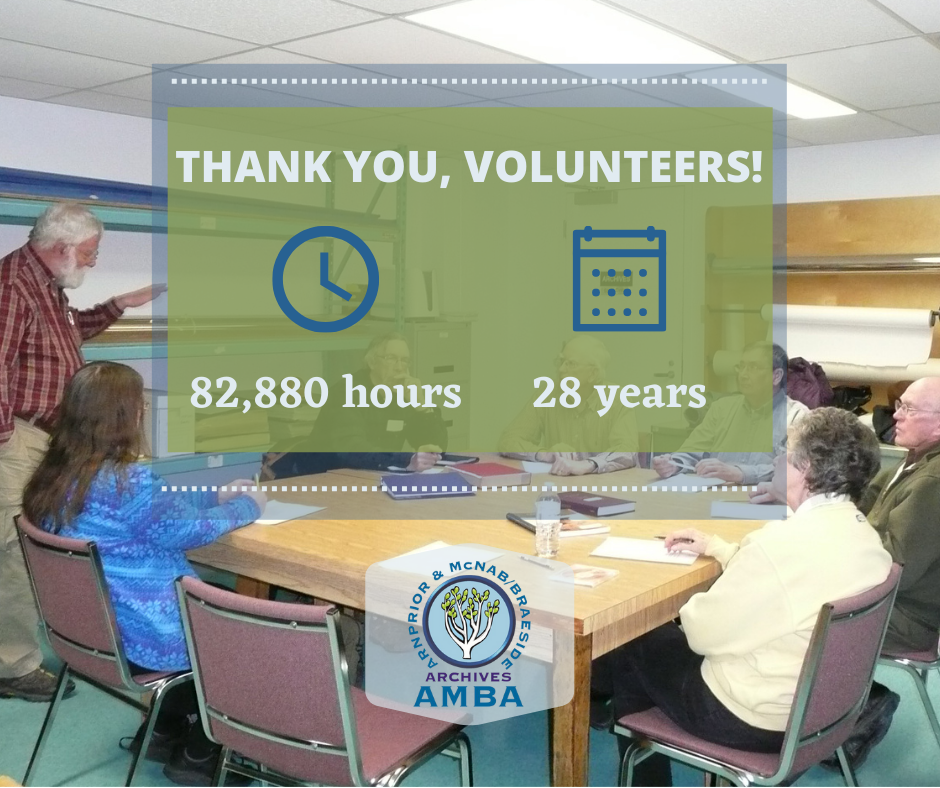
V is for Volunteers!
In an average year, volunteers at AMBA contribute close to 3,000 hours of work to the archives!
They help in the reading room, answering researchers' requests and documenting those requests for future researchers. They work on special projects that range from building shelving units to creating guides to using our records. They also contribute their knowledge and community connections in facilitating donations, investigating mysterious objects and photographs, and representing the archives at local events. They are truly the backbone of the archives, and without them the AMBA would not be what it is today.
Interested in becoming a volunteer with the AMBA? We would love to hear from you. You can send us an email with your contact information, availability and particular interests and skills. While we are not actively recruiting for archives volunteers, we always have new projects on the horizon for which you could be a perfect fit!
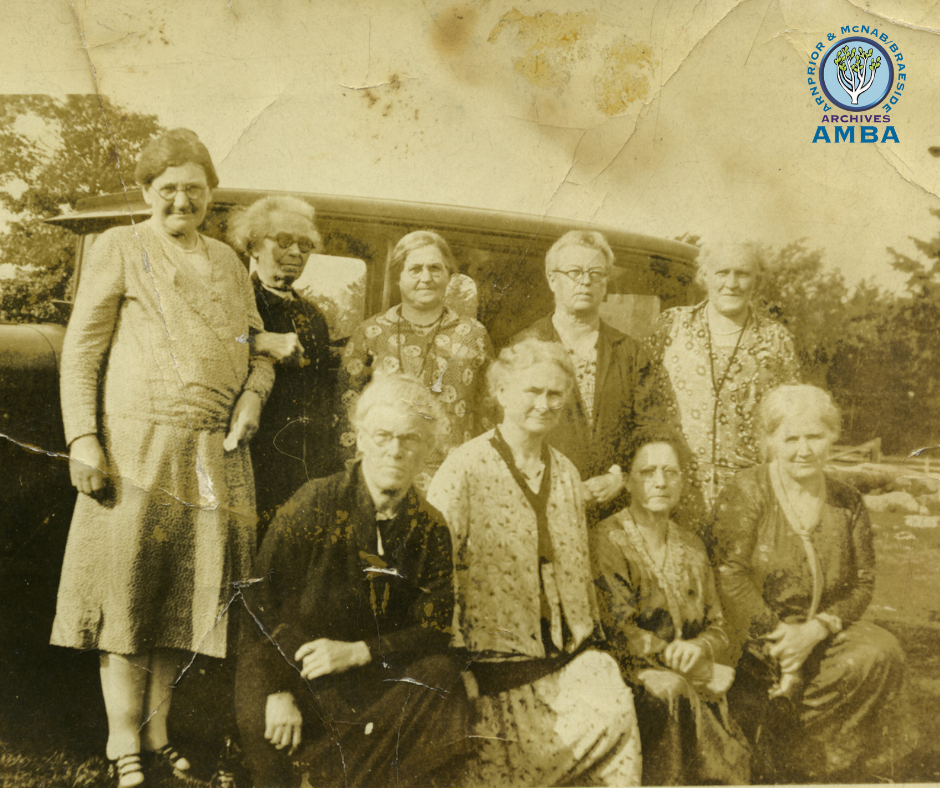
W is for Women's Institutes!
Since 1897, more than 2,000 Women's Institute (WI) Branches have existed across Ontario. They were founded to share knowledge for the benefit of rural women and were instrumental in preserving the history of rural areas across the province.
Individual branches created their own Tweedsmuir Community History Books (Tweedsmuirs as they are commonly known). These are scrapbooks and/or printed volumes that capture and preserve local community history, including histories about the earliest settlers, farming and industry practices, churches, schools and local institutions, and lots of photographs and information on people and places of interest.
AMBA holds a collection of Tweedsmuirs for various institutes of the Arnprior and McNab/Braeside regions. Today, these can be accessed digitally by visiting the website of the Federated Women's Institutes of Ontario (FWIO).
Want to learn more? Check out the March blog post on our website.
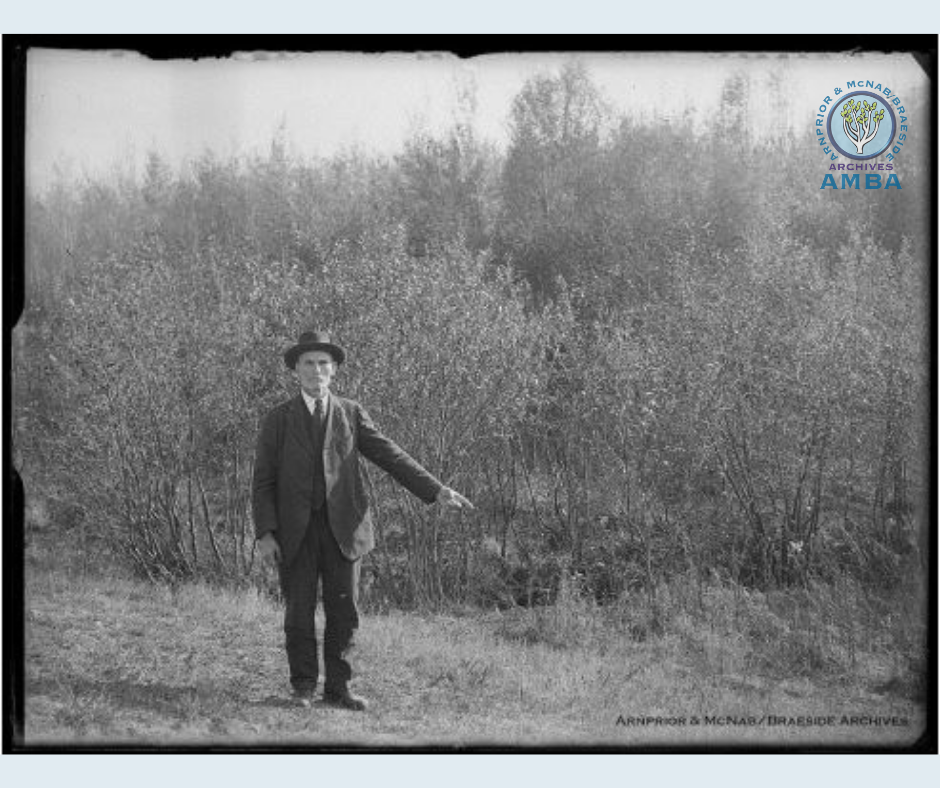
X Marks the Spot!
X marks the spot on this map recording the location where Champlain's Astrolabe was found.
In August 1867, Edward G. Lee, then only 14 years old, found a brass astrolabe at Green Lake near Cobden, Ontario. It is supposed to have been lost by Samuel de Champlain on his journey up the Ottawa River in June 1613.
The 1613 party had chosen to portage in the small lakes of the area in order to avoid the rapids of the river. There, Champlain is said to have lost his astrolabe. It remained in this location for over 250 years before Lee found it. The hand-drawn map of Champlain's supposed route through the Ottawa Valley was rendered by Charles Macnamara, who became fascinated with its history.
The photograph was captured by Charles Macnamara in 1919 and features an older Lee pointing to the spot where he first saw the artifact. In 1867, Lee had intended to sell it for $10 to Captain Cowley, who ran a steamboat on Muskrat Lake. In the end, the Captain took it and never paid him.
The 1613 party had chosen to portage in the small lakes of the area in order to avoid the rapids of the river. There, Champlain is said to have lost his astrolabe. It remained in this location for over 250 years before Lee found it. The hand-drawn map of Champlain's supposed route through the Ottawa Valley was rendered by Charles Macnamara, who became fascinated with its history.
This particular astrolabe was made in France around 1603 and is in excellent condition, except for one missing piece that was likely lost in the late 19th century.
For more information, visit the online exhibit, created by Summer Student Ryan Tobalt in 2013.
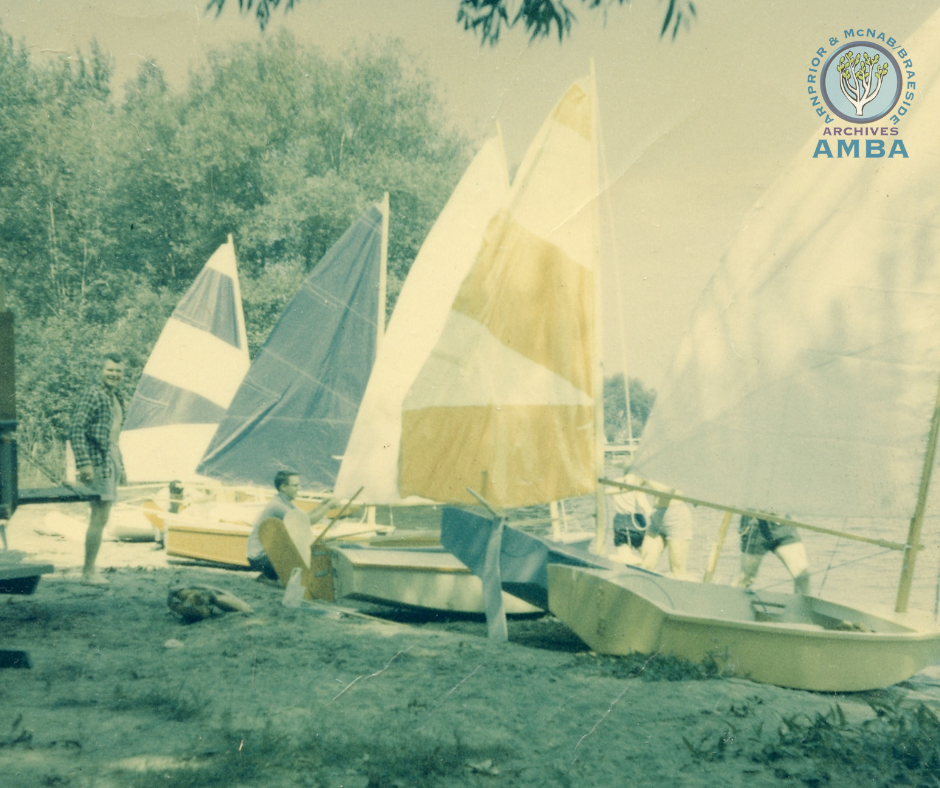
Y is for Yacht!
The Chats Lake Yacht Club followed an earlier club known as the Sandy Beach Yacht Club which operated in the mid-1940s. In 1962, Colonel Les Smith contacted the Canadian Boat Federation and formed the Chats Lake Boat Club with the purpose of promoting water safety and boatmanship for younger members, personal recreation and proper charts of the Ottawa River.
In 1971, the Town of Arnprior leased the present site in Bell Park for "the quiet enjoyment of the people of Arnprior." The featured photo shows the laying of the foundation for the clubhouse. By December of 1972 the Constitution was written outlining the purposes and objects of the club, which were "to establish, maintain and conduct a club for the accommodation and convenience of its members and to promote, foster and encourage boating for recreation and educational purposes".
The group is now known as the Chats Lake Community Boat Club, and is still active in 2022!
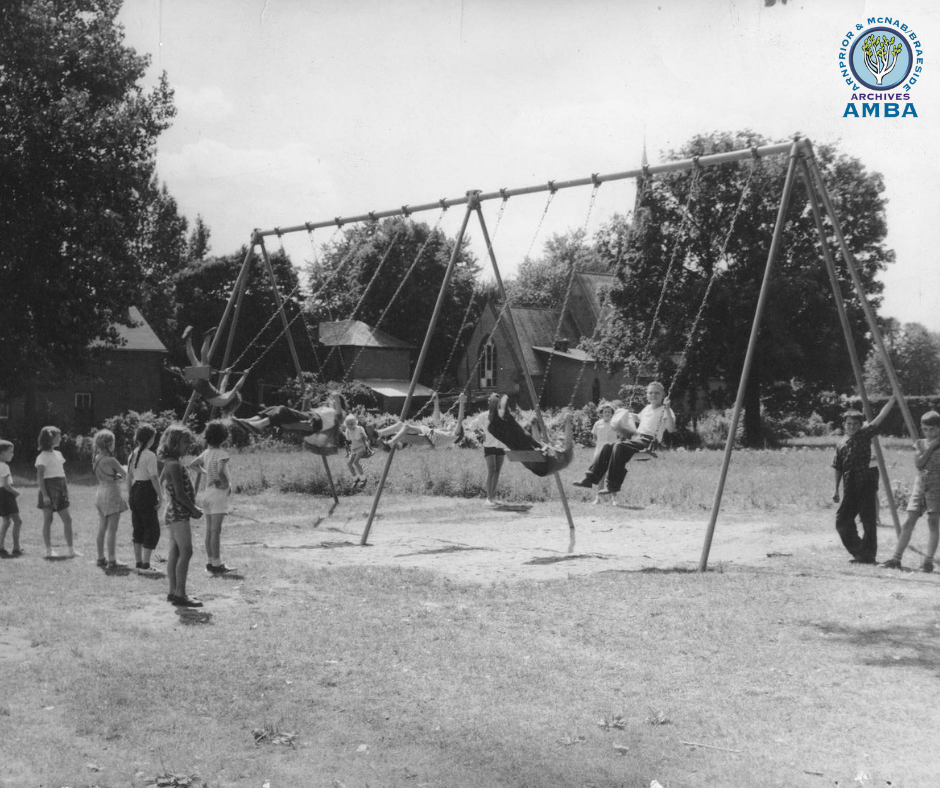
Z is for Zadow!
Walter Zadow Public School started as a Common School about 1860, and its first principal was Dugald C. McNab. The 2-room brick structure was at the corner of Harriet and Ottawa Streets, with its bell tower facing Harriet. These large rooms were the location of the great celebration when the Brockville & Ottawa Railway reached Arnprior.
In February of 1925, the building was levelled by fire. Classes were held in rooms all over town until a new school was built in June of that year. This building was an eight-classroom brick structure. Various additions were made to the building until the last addition of a third wing in 1972, officially opening in 1973. Walter Zadow now has an annual attendance of about 410 students!
Volunteers Dave and Mary Forsyth designed and printed a limited edition mug, featuring the school's history as well as its logo, which was chosen in a competition for student designs in 1985. These, along with various other mugs with historical themes like Arnprior Marble, ADHS, and the downtown core are for sale in our reading room for $16.00 each.
Thank you for liking, commenting and engaging with our posts, and check back in April of 2023 for a similar archives awareness campaign!
Inside the Vault: Vinegar Syndrome Inside the Vault: Women's Institute Coll…
Earlier Posts
2023 Archives A-Z: Photography Edition
AGM Event: Archives in Your Attic!
All About Ledgers in the Archives
Inside the Vault: Vinegar Syndrome
Archives A-Z: AMBA's April Social Media Posts
Inside the Vault: Women's Institute Collections
Inside the Vault: The Handford Studio Collection
Behind the Archives' Door: The Newspaper Project
A brief history of Robert Simpson Park
Graveside Stories: Senator J. J. Greene
Graveside Stories: Lindsay's Store
Graveside Stories: Finding Kathleen
Graveside Stories: the Cameron Family
